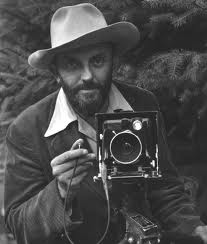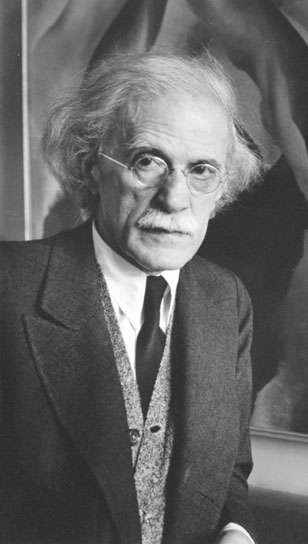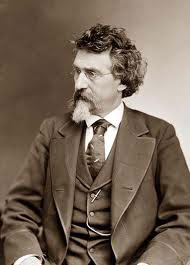Famous Photographers
Ansel Adams
 The American photographer Ansel Adams, b San Francisco, Feb. 20, 1902, d. Apr.
22, 1984, became a recognized leader of modern photography through his sharp and
poetic landscape photographs of the American West. Trained as a pianist, he
divided his time between music and photography until 1930, when, impressed by
the work of Paul Strand, he decided to concentrate fully on photography. The American photographer Ansel Adams, b San Francisco, Feb. 20, 1902, d. Apr.
22, 1984, became a recognized leader of modern photography through his sharp and
poetic landscape photographs of the American West. Trained as a pianist, he
divided his time between music and photography until 1930, when, impressed by
the work of Paul Strand, he decided to concentrate fully on photography.
In 1932 he had his first solo show in a major museum and, with Imogen
Cunningham, Edward Weston, and others, founded the influential Group F/64. In
1937, Adams moved to Yosemite, Calif., and after 1940 he photographed
extensively in the country's national parks. His sharply defined prints were in
marked contrast with the evocative work of earlier pictorialists and even
surpass the realistic detail of 19th-century landscape photographs.
Working exclusively in black and white, Adams used brilliant light to
produce intense images. His collections include My Camera in Yosemite Valley
(1949); Portfolio Two: The National Parks (1950); This Is the American Earth
(1960); Ansel Adams, Images 1923-1974 (1975); and The Portfolios of Ansel Adams
(1977). A one-man show, "Ansel Adams and the West," was exhibited in 1979 at the
Museum of Modern Art.
Alfred Stieglitz
 The principal American force behind the recognition of photography as a fine
art, Alfred Stieglitz, b. Hoboken, N.J., Jan. 1, 1864, d. July 13, 1946, was an
outstanding champion of the avant-garde in all the visual arts. Trained in
photographic technology in Berlin from 1883, Stieglitz first made his mark as an
amateur photographer of technical excellence whose genre subjects passed beyond
the anecdotal to penetrate the meaning of the scene itself. This concentration
on the force of life remained his primary interest. The principal American force behind the recognition of photography as a fine
art, Alfred Stieglitz, b. Hoboken, N.J., Jan. 1, 1864, d. July 13, 1946, was an
outstanding champion of the avant-garde in all the visual arts. Trained in
photographic technology in Berlin from 1883, Stieglitz first made his mark as an
amateur photographer of technical excellence whose genre subjects passed beyond
the anecdotal to penetrate the meaning of the scene itself. This concentration
on the force of life remained his primary interest.
After returning to New York in 1890, Stieglitz began promoting amateur
photography as of higher quality than the routine, unimaginative work produced
by his professional contemporaries. As the editor of American Amateur
Photographer (1893-96) and of Camera Notes (1897-1902) he gained international
recognition for such soon-to-be-famous American photographers as
Gertrude Kasebier, Edward Steichen, and Clarence H. White.
Influenced by avant-garde movements in Germany, Stieglitz
organized (1902) an impressive display of the finest pictorial photography at
the National Arts Club in New York, an exhibition that gave rise to the artistic
group of photographers known as the PHOTO-SECESSION. Stieglitz published the
work of this group in Camera Work from 1903 to 1917. During the same years
Stieglitz also exhibited, for the first time in the United States, the works of
such European painters and sculptors as Picasso, Matisse, and Brancusi.
In 1917 he closed the exhibition galleries to devote himself to
photography but again from 1925 to 1947 directed two galleries, first The
Intimate Gallery, then An American Place, where he exhibited the photography of
Ansel Adams, Eliot Porter, and Paul Strand and paintings by leading American
artists. Of his own work, his famous serial portraits of the painter Georgia
O'Keeffe, whom he married in 1924, and his cloud studies, called Equivalents
(c.1929), represent the most intimate expressions of his response to the world
around him.
Mathew B. Brady
 Mathew B. Brady, Warren County, N.Y., 1823, d. Jan. 16, 1896, was one of
the first American photographic entrepreneurs. In 1844 he opened a daguerreotype
studio in New York City; by 1860 he had two more (a second in New York City and
another in Washington, D.C.) through which he maintained a thriving portrait
business. Mathew B. Brady, Warren County, N.Y., 1823, d. Jan. 16, 1896, was one of
the first American photographic entrepreneurs. In 1844 he opened a daguerreotype
studio in New York City; by 1860 he had two more (a second in New York City and
another in Washington, D.C.) through which he maintained a thriving portrait
business.
In 1845 he began to make a series of portraits of famous
Americans, which he published as The Gallery of Illustrious Americans (1850). He
made more than one-third of the 100 known photographs of Abraham Lincoln. The
U.S. Civil War offered new scope for Brady's ambition. At an expense that
depleted his fortune, he outfitted perhaps as many as 20 photographers to cover
all fronts. Their equipment was too cumbersome to capture action, but their
thousands of pictures showed war in a new and brutal light. By the accepted
convention of studio photography, Brady's name appeared on all the images. Among
Brady's best Civil War photographers were Alexander GARDNER and Timothy
O'SULLIVAN, both of whom left Brady's employ in 1863.
The Selected Civil War Photographs Collection contains 1,118 photographs. Most
of the images were made under the supervision of Mathew B. Brady, and include
scenes of military personnel, preparations for battle, and battle after-effects.
The collection also includes portraits of both Confederate and Union officers,
and a selection of enlisted men.
Louis Auguste Bisson (1814-76) and Auguste Rosalie Bisson
Louis Auguste Bisson (1814-76) and Auguste Rosalie Bisson (1820-1900), were
brothers and partners in photography in Paris. There, in 1841, they opened a
studio for portrait DAGUERREOTYPES. By the end of that decade their studio had
become a popular meeting place for prominent artists and authors, whose
portraits were among the thousands made by the Bissons.
The brothers also daguerrotyped all the members of the National
Assembly--over 900 portraits, which were lithographed and distributed throughout
France. From 1851 they used F. S. ARCHER's collodion process to make landscape
and architectural photographs, for which they became famous. Official
photographers for NAPOLEON III, they accompanied him on a trip to the Alps in
1860 during which they made the first photographs from the summit of Mont Blanc.
|